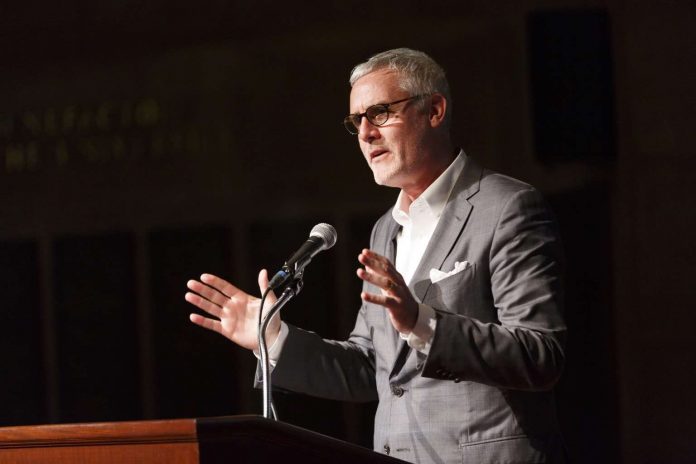For more than 25 years, Columbia University social psychologist Peter T. Coleman has studied what creates conflict—and what brings peace—around the world. In his new book, The Way Out: How to Overcome Toxic Polarization, he explores the factors that created the deeply divided United States of America we now live in. In our nation of warring tribes, the perception of what is fact or fiction depends on your ideology; romance with anyone of the opposing political party is frowned upon; and many feel increasingly angry, exhausted and pessimistic. Coleman goes on to discuss in great depth the different—if difficult—ways in which we might work to extricate ourselves from this morass.
Coleman is a member of the Earth Institute faculty, and co-executive director of the Advanced Consortium on Cooperation, Conflict and Complexity.
I recently spoke with him about insights he has developed over the years, and how recent events fit into the picture.
In your book, you say that the United States is more polarized than ever, the aftermath of the Civil War not excluded. What is the evidence?
Among many other things, our Capitol has been overrun by insurgents for the first time since the War of 1812. Our elected leaders vote against the proposals of their colleagues across the aisle more than they did when we first began collecting data, in 1879—just after the Civil War. This trend in Congress, which has neared complete partisan opposition, seems to have begun in the late 1970s. There are many other concerning trends like how everyday Americans feel, think and behave towards members of the other political party.
How did we get here?
There is a complex set of drivers feeding and reinforcing one another in strange ways. Nevertheless, there are a few deep structural elements. These include our 400-year legacy of white supremacy, which continues to traumatize and haunt us. Add to this the increasingly rapid demographic move toward majority non-white citizens, and repeated waves of severe economic downturns. This triggers great fear and anxiety in many whites. It’s a political gold mine for some politicians, who manipulate and weaponize them for their own gain. Over decades, fear-mongering has become central to the Republican playbook.
The 1960s and early ’70s were a time of great upheaval— political assassinations, the civil rights movement, an anti-war/anti-establishment movement, Roe v. Wade, Watergate, and profound cultural changes. Such times of political shock and instability are well-documented precursors to the onset of deeply rooted protracted conflicts. The Watergate scandal severely weakened the Republicans, until Reagan brought its conservative ideology roaring back in the 1980s. In the ’90s, Newt Gingrich tipped U.S. politics into zero-sum, winner-takes-all war. The result was a precipitous decline in bipartisanship in Washington, and a spike in enmity between camps. Trump and Trumpism were merely a logical, albeit extreme, extension.
Economic inequality is also driving political instability. The wealth gap between America’s richest and poorest families more than doubled between 1989 and 2016, and middle-class incomes have grown only slowly. Social mobility has plummeted. Some suggest that our cherished American institutions, heralded as highly inclusive and open to change, have become more “extractive,” where elites use state power to get rich through corruption or exploitation.
When COVID-19 hit, the middle and lower working classes were hit hardest. They are more likely to come into contact with others due to their employment, and have more underlying medical conditions like diabetes and chronic pulmonary disorders. This gap in the experiences between the wealthiest Americans and everyone else has intensified a deep feeling of injustice.
Finally, there’s the transformation of our media and information systems. It started with the 1987 dismantling of the Fairness Doctrine, which basically said news media must present fair and balanced reporting. Then, the “entertainmentization” of news, and the exponential growth of social media. Most recently, the intentional misinformation campaigns launched by foreign actors and by the Trump administration and its proxies, have all contributed to what some have called our current state of American Psychosis. That is, two parallel, opposing information ecosystems that have effectively delegitimized facts, and today accelerated our cultural addiction to outrage.
You briefly mention your own life: escape from a violent family situation in Chicago at 10, raised by a single mom in Iowa, living on welfare, working menial jobs. Eventually you earned a PhD., and now occupy an ivory-tower perch here in New York City. You’ve seen the world from various angles. How has that shaped your approach to social conflict?
Conflict is more than a concept to me. I have experienced extreme versions personally and professionally. Growing up in the 1960s in Chicago, I experienced school desegregation, a violent anti-war movement, and the civil rights movement. That instilled in me a strong sense of concern over the state of our society and our world. After working with violent youth in New York City in the 1980s, I returned to school to learn how to bring the power of ideas and science to bear on addressing social ills.
But the economic and geographic circumstances of my upbringing most shaped how I think about our political divide. Being able to work my way into better circumstances, due to luck, hard work and white privilege, has given me a sense of compassion for both sides. I still get angry and outraged like most of us these days, but I am hesitant to judge them. Because I am them.
Just in the first half of 2021, we’ve moved to where a third of the country thinks the last election was a fraud, and many scorn public-health measures against the coronavirus. It seems to me, things are rapidly getting worse. Yet you suggest the pandemic and even the Jan. 6 insurrection present possibilities for making things better. How can that be?
Because these are shocks upon shocks, which can destabilize the powerful constellation of forces that are creating cultural riptides today much bigger than any of us. And what we have learned from the study of when deeply divided societies change course and choose peace, is that they usually follow periods of great instability, when people are miserable, and so they seriously reconsider their basic assumptions and regroup. We are currently in such a time.
How do we start talking to people whom we view as enemies?
It depends on what you want to come of it. If you want to argue, fight, shame, and convince them that you are right, then jump in, have at it, and good luck. Most of us tend to enter these conversations as debates, and end up escalating the tensions or worse. If your intention is to learn something—to try to understand them or the issues under contention—then you may want to try something radically unfamiliar to most of us: dialogue. Dialogue is a process of learning and discovery about them, the issues and ourselves. It is countercultural in America, so it usually needs to be facilitated by a third party. But ideally, it results in a process of hearing the other and being heard that can trigger important shifts within and between us.
It seems likely that we will continue to have fundamental disagreements no matter how much talk. How can we learn to live with each other and move on?
Given the deep sources of our division, talk is insufficient. Real, sustainable change in our political climate will require action. That is, mobilization and reform of the structures operating within our media, political, justice and economic systems. In other words, genuine reform will likely take a concerted social movement. In my book, I describe one such process that happened over the abortion divide in Boston in the 1990s. I feel it can serve as a useful parable on what community-driven action can look like.
New York Times columnist David Brooks recently wrote that if World War II were to happen today, we would lose. Because we no longer possess national cohesion, nor a trust in institutions or each other. How long could it take for things to improve, if they do at all? And might the country fall apart in the meantime with the next big shock?
This is hard to predict. Typically, external threats to nations are unifying forces. This is usually true with threats from nature or from outsiders. But as we have seen recently, with COVID-19 or the recent wildfires in the West, or the Russian hacking of our elections, leadership and messaging matter. When political and media leaders weaponize such threats for their own gain, they can channel these forces to divide rather than unify. And right now, America is highly susceptible to such ploys. So, unless we effectively address our culture of contempt or find ways to hold divisive leaders accountable, the future could be bleak.




